OSAKA CASTLE
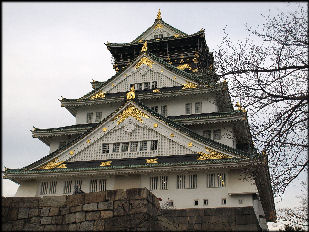
Osaka Castle (ten minute walk from several subway and train stations) is a concrete replica of one of Japan's most famous castles. The outside facade looks impressive and authentic but the inside is a modern, air-conditioned museum with elevators.
Osaka Castle is built on a hill overlooking the modern business district of Osaka and has an eight-story-high, five-level donjon (keep) at its center and stone walls around the hill with colossal stones that weigh up to 130 tons and are size of six-tatami-mat rooms. Around the base of the hill is a wide moat.
Every year Osaka Castle welcomes about 1.8 million people and was regarded as Osaka’ss premier tourist attraction until Universal Studios was built. The observation deck at the top of the keep offers splendid views of the city and the mountains in the distance. It is open to 8:30pm in the summer, which allows an evening view of the city. At night the castle is illuminated with colored lights. Websites: Osaka Castle Site osakacastle.net ; Japanese Castle Explorer .japanese-castle-explorer.com ; Wikipedia Wikipedia Osaka Castle Map: osakacastle.net ; Osaka Castle Area Map ontheworldmap.co ;
History of Osaka Castle: The site of battles and intrigues in the James Clavell novel “Shogun”, the original castle built between 1583 and 1599 on the site of a Buddhist temple under Toyotomi Hideoyishi. Over 100,000 men were used raise in the main structure in three years.
The original structure was destroyed in 1615 when the Toyotomi clan was wiped out. Its replacement was burned down after it was struck by lightning in 1868. The stone walls were largely built during the Edo period (1603-1868) under the Tokugawa shogunate.
The present structure was built in 1931, mostly with money donated by 80,000 Osaka residents, and was extensively renovated in 1997. Its design is not based on the castle that burned down in 1665 but rather is based on the image in the background of a famous screen painting of a 1615 siege of the castle. The painting can be seen in the fifth floor of the museum.
Museums and Parks at Osaka Castle: The castle contains art objects, screens, scrolls, samurai armor and documents donated by the Toyotomi family. On the seventh floor there is a display of Hideyoshi's life. On the third floor is replica of the famous Golden Tea Room, small room with walls covered by gold leaf. A film about Hideoyishi, with English subtitles, and a 3-D laser show is shown in the theater on the first floor.
The old castle sits on the hill with the Osaka City Museum, Hokoku Shrine and other small historical buildings. Opposite the outer moat is Osakajo Hall and the modern skyscrapers of the Osaka Business Park.
Osaka Castle Park is large and contains lots of trees, bicycle trails and jogging and walking paths. Cherry trees bloom in April and plum trees bloom as early as late February. Streets musicians and bands sometimes play on the road leading from the Morinomiya JR train line. Many of Osaka's homeless people used to live in park but were kicked out. Osaka Castle occasionally hosts Noh performances
See Separate Articles: OSAKA: ITS HISTORY, PEOPLE AND ECONOMY factsanddetails.com ; OSAKA TOURISM, ENTERTAINMENT, SHOPPING AND TRANSPORT factsanddetails.com ; OSAKA DISTRICTS AND ENTERTAINMENT AREAS factsanddetails.com ; INTERESTING MUSEUMS AND FACTORY TOURS IN OSAKA factsanddetails.com ; OSAKA THEME PARKS AND AMUSEMENTS factsanddetails.com
Walk Around Osaka Castle

Castle view This course takes you on a historical journey through the streets of old Osaka, a stark contrast to the gleaming modern office blocks and department stores that surround you at every corner. From JR Osakajo-koen Station just in front of the castle park, it's only a short walk to the Osaka Castle Main Tower, which is a proud authentic-looking structure on the very grounds where the original castle once stood, and houses many cultural assets. In this area also lie the Ruins of Naniwanomiya, the remains of the old palace proudly preserved as a park.
You stroll around in the warm sunshine before heading to the nearby Osaka Museum of History where each floor transports you back to a different era in Osaka's long, vibrant life. Continue down the old backstreets towards Ikutama-jinja Shrine, then south down Genshojizaka Slope, Aizenzaka Slope, and all the way along this famous historical road known as Tennoji-nana-saka (seven slopes) lined with old dwellings.
As you enter Shitennoji Temple and walk to Japan's oldest Buddhist temple, Shitennoji Temple built in 593, you head down to the Osaka City Museum of Fine Arts, taking a detour through Shin-Sekai, (lit. New World) passing old, tasteful shops, restaurants and establishments, an echo of their former days as the proud forerunners of sweeping modernization. The retro shopping arcades are the places where the true Osakan character is most visible. You are sure to meet some interesting characters as you browse around the cheap stalls and take in the vibrant atmosphere, before going to Sumiyoshi Taisha Shrine with its elegant red bridge crossing the still ponds.
Osaka Aquarium
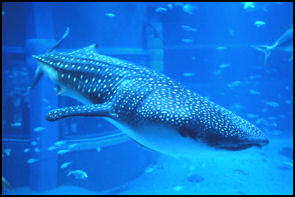
Osaka Aquarium (five minute walk from Osakako Station of the subway Chuo Line) is one of the world’s largest aquarium. It is a vast modern facility with a huge tank containing the world's only pair of captive whale sharks, and 18 smaller tanks, arranged accord to areas, like the Great Barrier Reef and Sea of Japan, with 35,000 sea creatures of 580 different species. The giant crabs are awesome. Other stars are the ocean sunfish, sea otters, penguins and dolphins. There is an indoor tropical rain forest and presentations in both English and Japanese.
The male and female whale sharks, named Kay-kun and Yu-chan, are impressive sights but it is little sad seeing them living in such a small place. Efforts to mate the whale sharks have been unsuccessful. The male shark is 4.5 meters long, weighs about a ton and is believed to be about nine or ten years old. He was caught in a net off the coast of Tosashimizu.
The tour begin with a walk through the 11-meter-long Tunnel Tank filled with reef fish and some small meter-long hammerhead sharks. After that you take a long escalator ride to the seventh floor and being working you way down stopping at tanks and aquariums themed by geographical location, starting with 1) the Japan Forest with otters, giant salamanders and trout; followed by 2) the Aleutian Islands, featuring sea otters; 3) Monterey Bay with harbor seals and California sea lions; 4) the Gulf of Panama, with porcupine fish and red-footed tortoises; 5) the Ecuador Rain Forest with capybaras, piranhas and giant freshwater fish such as the piraruca.
In 6) the Antarctica ection there are Adelie penguins, King penguins and Gentoo penguins. In 7) the Great Barrier Reef there are dozens of different kinds of reef fish including butterflyfish and angelfish as well corals, sea urchins and sea anemone. In the 10) Sento Inland Sea you can see octopus and lobster. 12) The Coast of Chile features Japanese anchovies. In the 13) Cook Strain there are porcupine fish and loggerhead turtles. The 9) Pacific Ocean is the aquarium’s huge central tank. Here you can see the two whale sharks as well as manta rays, zebra sharks, bubble-headed maori wrasses, mola mola, spinetail mobula, snub-nosed pompano and at least a half dozen other kinds of sharks. There are special sections with tanks full of different kinds of jellyfish and clownfish. In Japan Deep there are dozens of giant spider crabs.
Near Osaka Aquarium is the Tempozan Harbor Village, a popular waterfront district embracing the restaurants and shops of Tempozan Market Palace. You can also find Tempozan Contemporary Museum, with displays of holographic art and optical illusions. Near the Aquarium is the Tempozan Giant Ferris Wheel and the Suntory Museum with a 3-D IMAX Theater, Sightseeing tours are offered in motorized Santa Maria, Captain Line shuttle boats connect the Aquarium area with Universal Studios Japan, Website: Osaka Aquarium Kaiyukan Official Site kaiyukan.com
Shrines and Temples in Osaka
Temmangu Shrine (northeast of Nakonshima Park) was founded in 949 to honor Michizane Sugawara, a noted scholar of Chinese literature. The present shrine was rebuilt in 1845. Today many mothers come here to pray for success in their children on the university entrance exams.
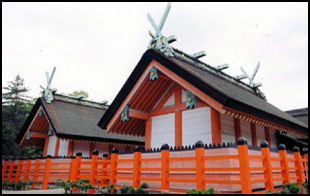
Sumiyoshi shrine Shitennoji Temple (Tennoji station) was the first Buddhist monastery built in Japan. Founded by Prince Shotoku (574-622) in 593, it contains a treasure house with 500 objects, various statues and shrines, as well as a stone torii gate, usually found at Shinto shrines, not Buddhist temples. The original structures were built in 1294. Most of the present buildings are concrete reproductions rebuilt after World War II. There is more gravel than gardens.
Zuikoji Temple in Higashi-Yodogawa Ward in Osaka contains a unique bridge made of whale bones. Rebuilt in 2006, it is three meters wide, six meters long and is made from jaw-bones and scapulas of three whales. The first bones used to make the bridge were donated by fishermen expressing their thanks for a bountiful harvest. The first bridge was made in 1756 and rebuilt with new bones in 1829, 1923 and 1974. the reconstruction in 2006 was done with the bones of three 12-meter-long minke whales.
Tennoji Park (southwest of Shitennoji Temple) is the home of the Municipal Art Museum, "Keitakuen" Japanese Garden, Botanical Conservatory, Municipal Zoological Gardens and other cultural and sports facilities. Tennoji Area Map: Tennoji Area ontheworldmap.com; Tennoji Station JR West westjr.co.jp/global/en/travel/shopping
Sumiyoshi Taisha Shrine (Sumiyoshi Taisha station) is where navigators traditionally prayed for safe passage to the deities of the sea and sea travel. Among its features are a torii gate, a humpbacked bridge in a park and 700 stone lanterns donated by sailors and shipowner throughout the centuries. According to legend the shrine was founded by Empress Jingu in the A.D. 3rd century to offer thanks to three gods for their protection on a journey to Korea. The current structure was built in 1808.
Tall Buildings and Ferris Wheels in Osaka
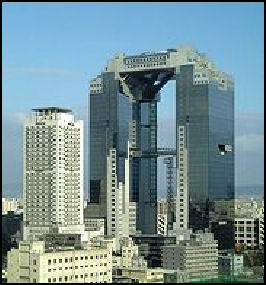
Umeda Sky Building Places of Interest in Osaka include the 103-meter-high Tsutenkaku Tower, built in 1912, modeled after the Eiffel Tower, and dismantled before World War II and rebuilt afterwards; Nakanoshima, a large civic center located on a small delta in the Yodo River with many office buildings; and Osaka Port, the third largest port in Japan after Yokohama and Kobe and the embarkation point for sightseeing boats headed for the Inland Sea National Park.
Tall Buildings in Osaka include the 256-meter-high WTC Osaka World Trade Center, the highest building in Osaka, the 255-meter-high Rinku Gate Tower Building (near Kansai Airport), the second highest buildings in Osaka; the 252-meter-high Cosmos Tower with a 55th floor observation deck; the mammoth Asia-Pacific Trade Center; and Intex Osaka, an international exhibition area, with six halls and nine zones.
Ferris Wheels include the Hep Five on top of a shopping complex in the Umeda area. It is 75 meters in diameter and has 52 gondolas, which reach a height of 106 meters above the city. There are great views of the Umeda entertainment district. There is also a 100-meter-in-diameter Ferris wheel with 60 four-person gondolas in Tenpozan, and a 100-meter-in-diameter one at Biwako Tower with 64 six-person gondolas in Otsu, north of Kyoto.
Tsuruhashi Korea Town (Tsuruhashi station on the JR Loop Line) is the largest Korea town in Japan. It main attraction is its restaurant, including many original “yakuniku” (Korean-style barbecues). The shopping is also good.
Koshien Stadium is the home of the Hanshin Tigers, a major institution in Osaka. Try to see a game if you can. The park is nearly always filled and the fans are fanatic as Red Sox fans except they pound plastic thunder sticks and do organized cheers throughout the game and set off balloons en masse in the seventh inning. Koshein is Japan’s oldest extant stadium. Built in 1924, it also hosts Japan’s main high school baseball tournaments, spectacles in themselves that can be viewed for free in the spring and summer.
Kansai Airport
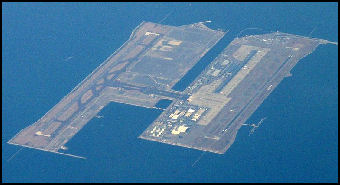
Kansai International Airport (Kansai official site 15 miles outside downtown Osaka) is the world's most expensive airport and one of the most ultra-modern ones. Built three miles offshore on a 1,250 acre artificial island at a cost $14 billion, it opened in 1994 as was declared one of the greatest engineering achievements of the 20th century by the American Society of Civil Engineers along with the Empire State Building, Panama Canal and Golden Gate Bridge.
The artificial island was created by sand mined from sites in the airport area and carried to the site by special hopper barges that dump the sand on the sea bed or feed it to barges that dump it on the island or into dump trucks the spread the sand around, Eight large sand piling barges — designed for deep sea operation — drove 1.2 million tons of sand into the sea floor before the island was produced to improve drainage and firm up the sea floor about 20 meters below the surface
The mile-long arched terminal at Kansai Airport was designed by the famed Italian architect Renzo Piano. It features huge drapes on the ceiling that direct air though the airport, a large multi-level shopping area, glass elevators and suspended walkways. Across from the terminal is hotel. A 3,750-meter-long double decker bridge connects the Osaka with the airport. The upper level is for vehicles and the lower level is for electric trains.
The airport sinks at a rate of one millimeter ever day; keeping it level is a web-like network of enormous hydraulic jacks. Between 1987, when construction began, and 2001 the ground beneath the airport had subsided 38 feet and is expected to sink another three feet before it stabilizes. As of 2001, the airport operator had spent $2.21 billion on repairs, including a concrete wall in the terminal's basement to prevent seawater seepage. To pay for all this the airport charge some of the world’s highest landing fees and departure taxes ($22).
Even though Kansai handles about 20.5 million passenger a years. This is far less than expected. As a result of this and debts accrued from construction and repair had cost the airport about a $1 billion a year. Kansai airport turned a profit for the first time in 2004 but only managed that with government subsidies.
The new 4000-meter-long second runway — the longest in Japan and considerably longer than Kansai’s first 2,500-meter-long runway — opened at Kansai in 2007. Built on a new reclaimed area about the size of the first, it has been criticized for being too expensive and too far away from the terminal. Requiring planes to taxi for six kilometers and 10 minutes to reach the terminal. Construction of the second terminal to go with the new runway has been delayed.
Landing fees at Kansai are the world’s highest, and 50 percent higher than those at Narita. Some airlines — including American, United and Air Canada — have discontinued routes to Kansai. To make up for a lack of passengers Kansai is trying to market itself as cargo delivery hub and attract more planes from Asia, particularly China.
The second runway has been infested with locusts. There were worries that large insects could be present a potential hazard for aircraft landing or taking off. A major eradication effort was launched to get rid of them before the runway opened, A similar problems occurred when the first runway opened and it was temporarily closed because of airlines complaining about insects getting sucked into engines and splattering on the cockpit windshields.
Transportation from Kansai Airport to Osaka: Kansai International Airport has a JR station at the airport (tickets are around US$10 to most destinations). Airport limousine buses, costing about US$8, run regularly to hotels and other destinations in Osaka and taxis cost about US$40. Website: Kansai Official Soite Transporation
Parks in the Osaka Area
Expo Memorial Park (Suita, a western suburb of Osaka) is a popular recreation area and home to the Japan Folk Crafts Museum, the National Museum of International Arts, the National Museum of Ethnology, the Garden of Nature and Culture, a Japanese garden and other facilities.
Expo Memorial Park was the sight of the 1970 World Exposition, the first ever World Exposition held in Asia. It attracted 64.21 million visitors, almost three times number that visited the Expo in Aichi in 2005 . The massive Tower of the Sun statue near the entrance is the symbol of the park. Designed by Okamoto Taro, the metal and concrete structure is considered by many to be ugly monstrosity. There are lots of cherry and plum trees in the park..
The park is reached by a monorail which offers impressive views of suburban Osaka and the nearby mountains. Expoland, a nearby amusement park with several rollercoaster, was closed in 2008 after people died in a roller coaster accident. Paramount plans to build a new theme park at the Expoland site.
Open Air Museum of Old Japanese Farmhouses (Ryokuchi-koen Park, Suita, a western suburb of Osaka) is a group of nine thatch-roof farmhouses, each representing a different regional style.
Mino (30 minutes from central Osaka by train) is a waterfall park with monkeys. Sights include 100-foot-high Mino waterfall; Ryuanji Temple, founded by an ascetic who liked to stand under cold waterfalls; the Insect House, with displays of dead and living bugs; Saikoji Temple; and Katsuoji Temple. The Mino Tourist hotel at Mino Onsen has two indoor segregated baths and an outdoor one for women only with spectacular views.
Mino is a popular destination in the autumn. There are many beautiful maple trees. Restaurants sell deep-fried maple leaves as a snack. The spring is cherry blossom-viewing time. There are lots of hiking trails in the Mino area. The are awesome views of Osaka from the tops of some mountains.
Islands and Birds in Osaka
Nanko Yacho Koen Bird Sanctuary (near the Hyatt Regency and Nakafuto Station) is a surprisingly serene and pleasant retreat built on land reclaimed from a former industrial park. Near the International Exhibition Center you can borrow a bicycle for free to explore the area. And yes there are birds here. A variety of seabirds and waterfowl can be seen year round. Migratory bird make brief stops on their way north or south.
Port Town lies off of Osaka in the middle of four artifical islands. Christal Whelan wrote in Daily Yomiuri: of the four offshore artificial islands–Sakishima, Yumeshima, Maishima and Phoenix Island — Sakishima is the only one of the group built for human habitation; the others are related to waste disposal. The island center — known as Port Town — filled with condominium high-rises, has a population of 26,000. Through the center of town flows an artificial river. A variety of mushrooms now grow in the soil and on trees. In the 30 years since its completion, the vegetation has become luxuriant, a tribute to the persistence of life. The expression "trash-island" used to describe Sakishima often leads to a common misunderstanding that the island is somehow made up of cartons, bottles, old bicycles, and car wrecks. But the foundation of this island is a mixture of fine and gravely ash, essentially what remains after incinerating huge quantities of garbage.
Maishima Incinerator and Water Treatment plants look like something out of the Arabian Nights. The two minarets crowned with golden onion domes are actually the chimneys of the two plants. The incinerator handles 900 tons of trash per day from just two districts in Osaka. Christal Whelan wrote in Daily Yomiuri: “ Maverick Viennese architect Friedensreich Hundertwasser designed the exterior of these buildings. While not a Metabolist per se, Hundertwasser shared many of the movement's ideas, especially its insistence on organic design and its criticism of Modernist sterility. He ranted against "window apartheid," the compulsion not to mix windows of different shapes and sizes in the same building. Not only was utilitarian and functional architecture uninhabitable, but it was immoral by his standards. Since straight lines and identical objects do not exist in nature, Hundertwasser incorporated curved lines into his shapes by crowning rooftops with trees, placing planters against walls, and adding uneven floors and nonlinear tables.
If what humans most yearn for in their lives is variety and a beauty harmonious with nature, Hundertwasser gave it to us in this building. The Maishima Incinerator is a boldly life-affirming structure from an artist with a buoyant spirit bent on creating happy habitats wherever humans happen to live or work. Maishima Incinerator Plant, 1-2-48 Hokko Shiratsu, Konohana-ku, Osaka 554-0041, Inquiries: Mon.-Fri., 9 a.m.-noon, 1-5 p.m, Tel: (06) 6630-3353, Reservations required for visit
Kofun of the Osaka Plain: UNESCO World Heritage Site
Mozu-Furuichi Kofun Group: Mounded Tombs of Ancient Japan in the Osaka area was designated is a UNESCO World Heritage Site in 2019. These burial mounds come in various sizes and shapes such as key holes, scallops, squares or circles. These tombs were for members of the elite and form the richest material representation of the Kofun period, from the A.D. 3rd to the 6th century. They demonstrate the differences in social classes of that period and reflect a highly sophisticated funerary system. [Source: UNESCO]
According to UNESCO: ““Located on a plateau above the Osaka Plain, the Mozu-Furuichi Kofun Group is a serial property of 45 components which contains 49 kofun (‘old mound’), a large and distinctive type of burial mound. The selected kofun are found in two major clusters, and are the richest tangible representation of the culture of the Kofun period in Japan from the 3rd to 6th centuries, a period before Japanese society became an established centralised state under the influence of the Chinese system of law.
”The kofun have a range of contents, such as grave goods (weapons, armour, ornaments) ; and clay figures used to decorated the mounds, known as haniwa (in the form of cylinders arranged in rows, or representations of objects, houses, animals and people). Understood as tombs for kings’ clans and affiliates during this period, some of the kofun are Ryobo (imperial mausolea) and are managed by Japan’s Imperial Household Agency. The serial components have been selected from a total of 160,000 kofun from around Japan and represent the ‘middle kofun’ period (late 4th to late 5th centuries) which is considered to be the peak of the Kofun period.
”The attributes of the property are the 49 burial mounds, their geometric forms, methods and materials of construction, moats, archaeological materials and contents (including grave goods, burial facilities and the haniwa). The settings of the kofun, their visual presence in the Osaka region, and the remaining physical and visual links between the kofun are important attributes; as is the evidence of the distinctive funerary practices and ritual uses.
Kofun in the Osaka Plain
The mounds are in two clusters — the Mozu cluster in Sakai, which includes Emperor Nintoku’s tomb, and the Furuichi cluster, which stretches across Habikino and Fujiidera. The latter includes Emperor Ojin’s tomb, Japan’s second-largest ancient tomb. [Source: Yomiuri Shimbun, June 25, 2013]
The burial mounds include the tomb of Emperor Nintoku, one of the world’s largest at 486 meters long. Along with the Great Pyramid of Giza in Egypt and the Mausoleum of the First Qin Emperor in China, it has been dubbed one of the three great ancient tombs. Many of the tombs, which were built from the late fourth century to the early sixth century, are distinctly shaped like a keyhole, including that of Emperor Nintoku.
According to UNESCO: The Mozu and Furuichi groups of kofun provide a cohesive narrative of the kingly power expressed through the clustering of the 49 kofun, the range of types and sizes, the grave goods and haniwa, and the continuing ritual uses and high esteem that these sites hold within Japanese society.
While 160,000 kofun are found throughout Japan, the Mozu-Furuichi Kofun Group represents and provides exceptional testimony to the culture of the Kofun period of Japan’s ancient history. The 45 components demonstrate the period’s socio-political structures, social class differences and highly sophisticated funerary system.” In addition, the “Mozu-Furuichi Kofun Group demonstrates an outstanding type of ancient East Asian burial mound construction. The role of the kofun in the establishment of social hierarchies within this particular and significant historical period, as well as the tangible attributes such as the clay sculptures, moats and geometric terraced mounds reinforced by stone, are outstanding.
Image Sources: 1) 2) 5) Ray Kinnane 3) 7) 9) Wikipedia 4) 6) 8) Osaka Visitor's Guide
Text Sources: JNTO (Japan National Tourist Organization), Japan.org, Japan News, Japan Times, Yomiuri Shimbun, Japan Ministry of the Environment, UNESCO, Japan Guide website, Lonely Planet guides, New York Times, Washington Post, Los Angeles Times, National Geographic, The New Yorker, Bloomberg, Reuters, Associated Press, AFP, Compton's Encyclopedia and various books and other publications.
Updated in July 2020
